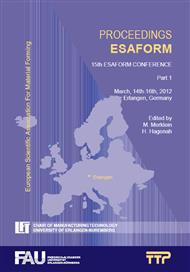p.1311
p.1317
p.1323
p.1329
p.1335
p.1341
p.1347
p.1353
p.1359
White and Dark Layer Analysis Using Response Surface Methodology
Abstract:
This paper presents a study of the influence of cutting conditions on the finished surface obtained after an hard turning process, in particular a case study is presented where AISI 52100 bearing steel is machined under different cutting conditions. An analysis carried out using Surface Response Methodology has been developed in order to study the influence of the main cutting parameters such as cutting speed, feed rate and workpiece initial hardness on white (WL) and dark layer (DL) thickness. The whole experimental campaign has been performed using a chamfered PCBN tool inserts without any cutting fluid. Results show an evident influence of cutting speed and feed rate on both white and dark layer thickness while less relevant is the contribute given from the workpiece hardness on defining WL and DL depth. Finally, a model to find the optimal process conditions to minimize white and dark layer thickness is developed.
Info:
Periodical:
Pages:
1335-1340
Citation:
Online since:
February 2012
Keywords:
Price:
Сopyright:
© 2012 Trans Tech Publications Ltd. All Rights Reserved
Share:
Citation:


